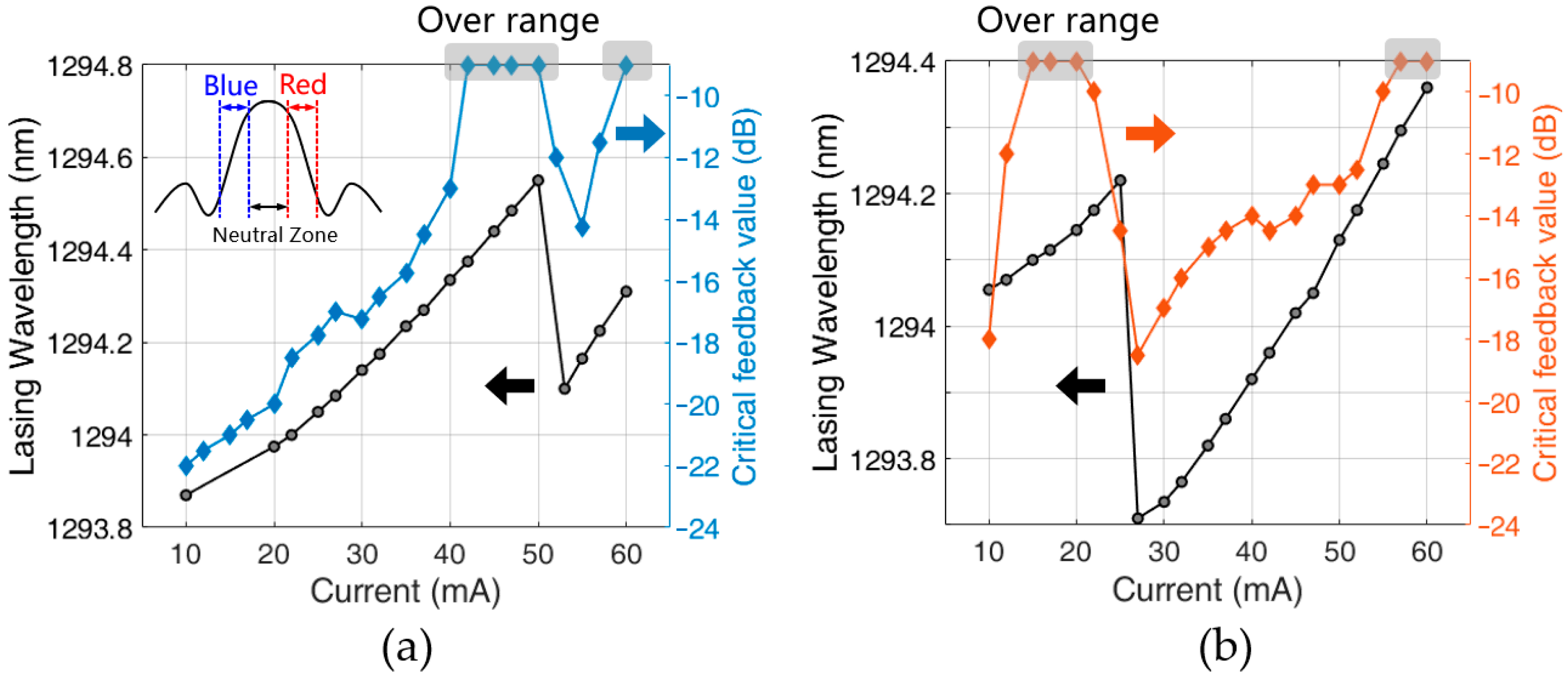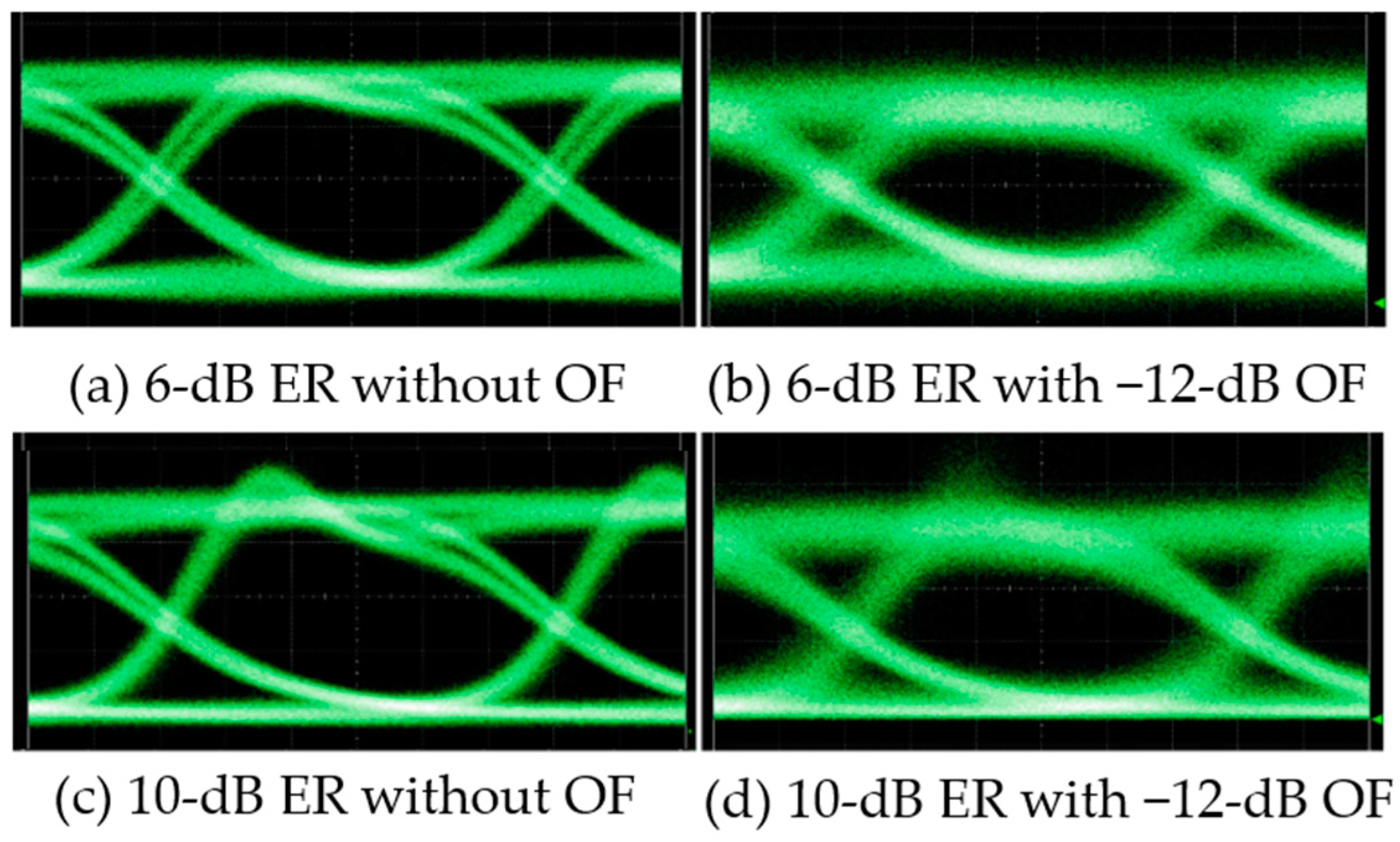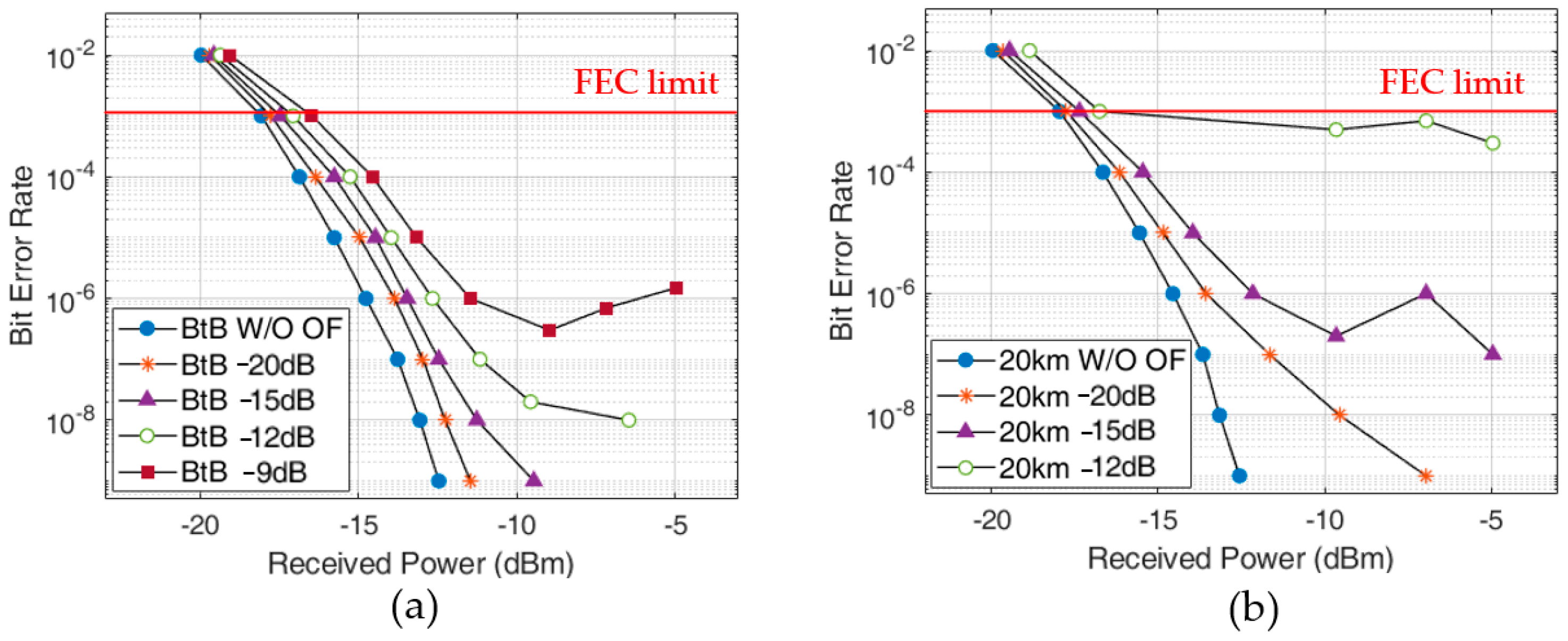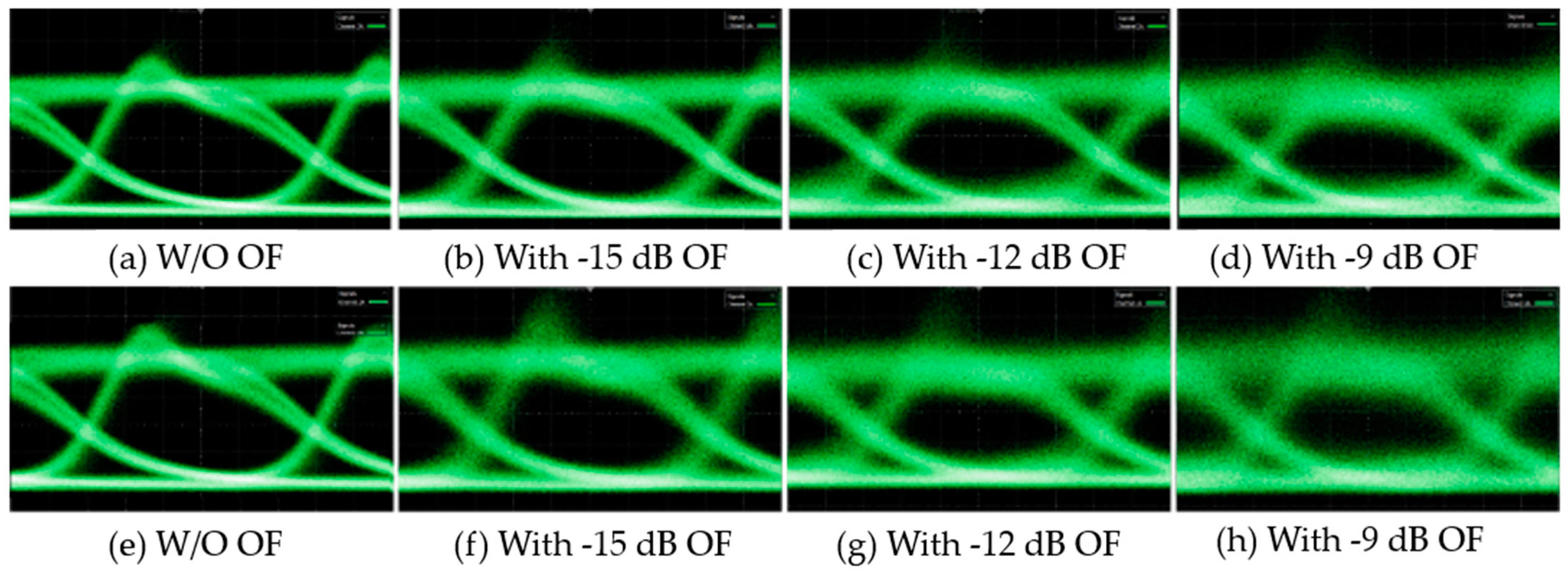High Optical Feedback Tolerance of a Detuned DBR Laser for 10-Gbps Isolator-Free Operation
Abstract
1. Introduction
2. Device Structure and Experimental Setup
3. Results
3.1. Static Performance under Feedback
3.1.1. RIN Spectrum
3.1.2. Critical Feedback Value
3.2. Modulation Performance under Feedback
3.2.1. Signal-to-Noise Ratio of the Eye Diagram
3.2.2. BER Property and Eye Diagram
3.2.3. Power Penalty
4. Discussion
5. Conclusions
Author Contributions
Funding
Institutional Review Board Statement
Informed Consent Statement
Data Availability Statement
Conflicts of Interest
References
- Tkach, R.W.; Chraplyvy, A. Regimes of Feedback Effects in 1.5 μm Distributed Feedback Laser. IEEE J. Light. Technol. 1986, 4, 1655–1661. [Google Scholar] [CrossRef]
- Huang, Y.; Yamada, H. External optical feedback resistant characteristics in partially-corrugated-waveguide laser diodes. In Proceedings of the Optical Fiber Communication Conference, Jose, CA, USA, 25 February–1 March 1996. [Google Scholar]
- He, Y.; Zhang, Z.; Lv, Z.; Yang, T.; Lu, D.; Zhao, L. 10-Gbps 20-km Feedback-Resistant Transmission Using Directly Modulated Quantum-Dot Lasers. IEEE Photonics Technol. Lett. 2020, 32, 1353–1356. [Google Scholar] [CrossRef]
- Matsui, Y.; Schatz, R.; Che, D.; Khan, F.; Kwakernaak, M.; Sudo, T. Isolator-free > 67-GHz bandwidth DFB+R laser with suppressed chirp. In Proceedings of the Optical Fiber Communication Conference, San Diego, CA, USA, 8–12 March 2020. [Google Scholar]
- Matsui, Y.; Schatz, R.; Che, D.; Khan, F.; Kwakernaak, M.; Sudo, T. Low-chirp isolator-free 65-GHz-bandwidth directly Modulated Lasers. Nat. Photonics 2021, 15, 59–64. [Google Scholar] [CrossRef]
- Lee, S.H.; Tajima, N.; Shindo, T.; Takahashi, D.; Nishiyama, N.; Arai, S. High optical feedback-tolerance of distributed reflector lasers with wire-like active regions for isolator-free operation. IEEE Photonics Technol. Lett. 2009, 21, 1529–1531. [Google Scholar] [CrossRef]
- Chen, M.; Shindo, T.; Kanazawa, S.; Nada, M.; Nakanishi, Y.; Nakamura, H. Enhancement of Optical-Feedback Tolerance of SOA-Integrated EML (AXEL) by Introducing DBR-Type Laser. IEEE Photonics Technol. Lett. 2020, 34, 502–505. [Google Scholar] [CrossRef]
- Nesset, D. NG-PON2 technology and standards. IEEE J. Light. Technol. 2015, 33, 1136–1143. [Google Scholar] [CrossRef]
- G.9807.1; Transmission Systems and Media, Digital Systems and Networks, 10-Gigabit-Capable Symmetric Passive Optical Network (XGS-PON). ITU-T: Geneva, Switzerland, 2020.
- Ahmed, M.; Yamada, M.; Mahmoud, S.W.Z. Analysis of semiconductor laser dynamics under gigabit rate modulation. IEEE J. Appl. Phys. 2007, 101, 033119. [Google Scholar] [CrossRef]
- Helms, J.; Petermann, K. A Simple Analytic Expression for the Stable Operation Range of Laser Diodes with Optical Feedback. IEEE J. Quantum Electron. 1990, 26, 833–836. [Google Scholar] [CrossRef]
- Grillot, F.; Thedrez, B.; Gauthier-Lafaye, O.; Martineau, M.F.; Voiriot, V.; Lafragette, J.L.; Gentner, J.L.; Silvestre, L. Coherence-Collapse Threshold of 1.3-um Semiconductor DFB Lasers. IEEE Photonics Technol. Lett. 2003, 15, 9–11. [Google Scholar] [CrossRef]
- Tronciu, V.; Werner, N.; Wenzel, H.; Wunsche, J.H. Feedback Sensitivity of Detuned DBR Semiconductor Lasers. IEEE J. Quantum Electron. 2021, 57, 2100107. [Google Scholar] [CrossRef]
- Morthier, G. Feedback Sensitivity of DBR-Type Laser Diodes. IEEE Photonics J. 2021, 13, 1500205. [Google Scholar] [CrossRef]








| Feedback Level (dB) | ||||||||
|---|---|---|---|---|---|---|---|---|
| W/O OF | −30 | −20 | −15 | −12 | −10 | −9 | ||
| Penalty (dB) | BtB | - | 0.21 | 0.33 | 0.61 | 0.96 | 1.20 | 1.59 |
| 20 km | 0.01 | 0.18 | 0.32 | 0.75 | 1.27 | - | - | |
Disclaimer/Publisher’s Note: The statements, opinions and data contained in all publications are solely those of the individual author(s) and contributor(s) and not of MDPI and/or the editor(s). MDPI and/or the editor(s) disclaim responsibility for any injury to people or property resulting from any ideas, methods, instructions or products referred to in the content. |
© 2022 by the authors. Licensee MDPI, Basel, Switzerland. This article is an open access article distributed under the terms and conditions of the Creative Commons Attribution (CC BY) license (https://creativecommons.org/licenses/by/4.0/).
Share and Cite
Yang, Q.; Lu, D.; He, Y.; Zhou, D.; Zhao, L. High Optical Feedback Tolerance of a Detuned DBR Laser for 10-Gbps Isolator-Free Operation. Photonics 2023, 10, 38. https://doi.org/10.3390/photonics10010038
Yang Q, Lu D, He Y, Zhou D, Zhao L. High Optical Feedback Tolerance of a Detuned DBR Laser for 10-Gbps Isolator-Free Operation. Photonics. 2023; 10(1):38. https://doi.org/10.3390/photonics10010038
Chicago/Turabian StyleYang, Qiulu, Dan Lu, Yiming He, Daibing Zhou, and Lingjuan Zhao. 2023. "High Optical Feedback Tolerance of a Detuned DBR Laser for 10-Gbps Isolator-Free Operation" Photonics 10, no. 1: 38. https://doi.org/10.3390/photonics10010038
APA StyleYang, Q., Lu, D., He, Y., Zhou, D., & Zhao, L. (2023). High Optical Feedback Tolerance of a Detuned DBR Laser for 10-Gbps Isolator-Free Operation. Photonics, 10(1), 38. https://doi.org/10.3390/photonics10010038





